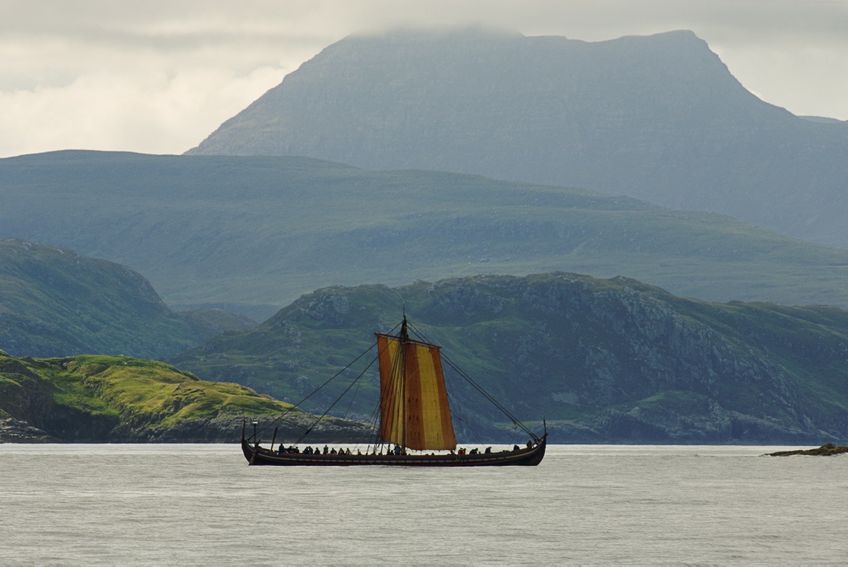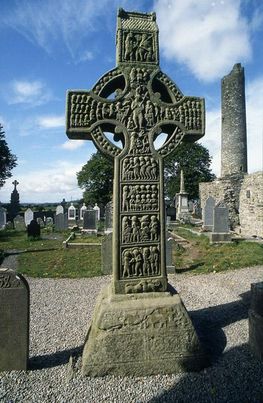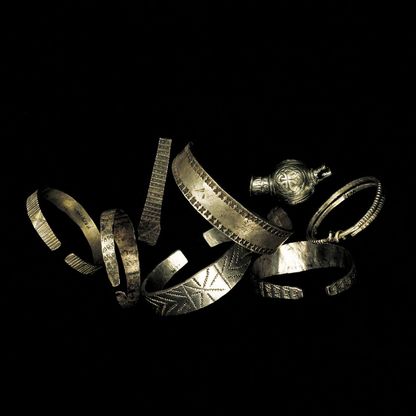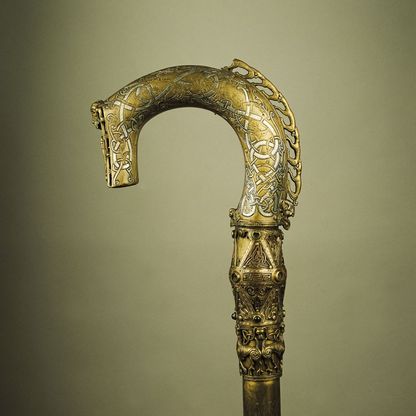The vikings in Ireland
Viking raids on Ireland began in 795. Rathlin Island on the north east coast was attacked and in the same year Inishmurray, Co. Sligo and Inishbofin, Co. Galway were also raided. Later, the attacks became more frequent and fleets of Viking ships appeared on the major rivers such as the Shannon, Boyne, Liffey and the Erne. By 841 the annals report that the Vikings were already spending the winter in Ireland, using temporary ship fortresses as bases for more extensive raiding. Some of these ship fortresses, or longphuirt, such as Dublin, Waterford and Wexford, were later to develop into towns but others, such as the ship base at Annagassan, Co. Louth were to lapse into obscurity. In this early period the principal targets were the monasteries which were the only large centres of population and wealth and the main quest was for loot and slaves. The Vikings did not only fight against Irish: by the mid-ninth century they served as mercenaries in battles between Irish kings.
The effects of the earliest attacks on Ireland are difficult to estimate. It is not likely that Vikings were responsible for the decline of the church and monastic culture. Many monasteries were never attacked, and attacks were not equally severe. Clearly the main target was the large wealthy monastic foundations such as Glendalough, Kildare and Clonmacnoise.
Although the Irish annals tell of the horror of the Viking raids and the destruction inflicted upon the monasteries, warfare was not new to Ireland. A number of monasteries, such as Clonmacnoise, maintained some form of militia. This force was probably in the form of lay tenants, and there are a number of records of battles prior to the advent of the Vikings to the Irish scene.
Heathen graves
The earliest archaeological evidence for Vikings in Ireland is in the form of pagan graves found from Co. Antrim in the north to Co. Galway in the west. The graves are distinctive in the archaeological record because, unlike the contemporary Christian Irish burials, they often contain a large number of artefacts.
They represent the remains of pagan Scandinavians and must belong the first few generations of Vikings in Ireland. Male graves contain weapons such as swords, spearheads and shields and the female graves contain personal ornaments such as oval brooches.
The Viking cemetery at Kilmainham in Dublin is one of the largest known outside Scandinavia. In the late tenth century the Irish Vikings adopted the local Christian faith.
Here we see Stone high cross at the monastic site of Monasterboice, Co. Louth; target of Viking attack in the ninth century. © The Dept. of Environment, Heritage and Local Government.
Trading cities and minting
In the tenth century, Vikings established towns at Dublin, Waterford, Limerick, Wexford and possibly Cork. The first use of money in Ireland dates from 997 when Dublin started minting Ireland's first coins. Dublin and Ireland became part of a wider international trade network than ever before. New trade routes were opened up by the Vikings into the silver- and gold-rich markets of Asia. Silver was acquired by trade, exchange and plunder, and came to Ireland largely in the form of coins which were melted down and made into ornaments. About 150 coin hoards are known from Ireland. These contain a combination of ornaments, chopped pieces of silver known as hack silver, ingots and coins. Viking Age silver in Ireland was converted into a variety of brooches and arm rings. Arm rings are hammered from a bar of silver, and sometimes bear stamped ornament. Other forms, such as torcs made of twisted silver wires, are less common. The fact that we have silver ornaments clearly made by Irish craftsmen indicates that significant amounts of silver found its way into Irish hands.
Fact: The Vikings popularised new art styles and probably popularised the wearing of shoes with separate soles and uppers, as well as the wearing of trousers. They also introduced new weapon types.
Ship-building
Studies of loan words from Old Norse to Irish shows the Viking impact on ships and shipping and evidence from archaeological excavation in Viking Dublin shows that ships were being built here according to Scandinavian methods. In the late Viking age control of and its powerful fleet became a prime concern to any hopeful holder of kingship of Ireland.
History Changes
Up to relatively recently, historians tended to reflect the sentiments of the Irish annalists, portraying the Vikings merely as marauders. Although there is no doubt that they did carry out many raids in Ireland, the nature of their contact with Ireland is far more complex than this. Archaeological excavation in Ireland the last fifty years has completely changed our perceptions of Viking influence in Ireland. Far from being just raiders, Vikings can be credited with developing urbanism in Ireland founding the island's major towns. With their knowledge of seafaring, they brought Ireland into contact with Britain and mainland Europe, something which was to have widespread political and economic consequences for Ireland. The Vikings were the catalyst of change in Irish political and cultural life. Their presence also influenced the organisation of the Irish Church. It may also have had an effect on the Church reform in the late eleventh and early twelfth centuries.
Exercises
The Vikings in Ireland
Rathlin Island is the site of the first recorded Viking attack on Ireland in 795 AD. A number of Viking graves, some with magnificent grave goods, and a Hiberno-Norse coin hoard from the 1040's has been found here.
Rathlin Island is located off the north west corner of Ireland and would be the first Irish landfall for seafarers travelling south along the west coast of Scotland.
Rathlin (known as Rechru in medieval Irish sources) was, in fact where the first recorded Viking raid on Ireland took place in 795A.D: Loscad Rechrainne o geinntib, ‘the burning of Rechru by heathens’. The Isle of Skye was overrun and laid waste at the same time.
Rathlin Island is surrounded by steep cliffs but the sandy beach of Church Bay was the site of the Viking landing. The strait between Rathlin and the Irish coast – site of the whirlpool known as Coire Brecain - was notoriously difficult to negotiate.
A modern church occupies the site of the early Irish monastery. In the 18thcentury a number of pagan Viking graves were found here, one of which included a magnificent 9th-century silver brooch, perhaps produced by a Norse craftsman adapting an Irish type of dress fastener to Norse taste. A hoard of Hiberno-Norse coins dating to the 1040s was also found on Rathlin.
By: Maeve Sikora, National Museum of Ireland
Exercises
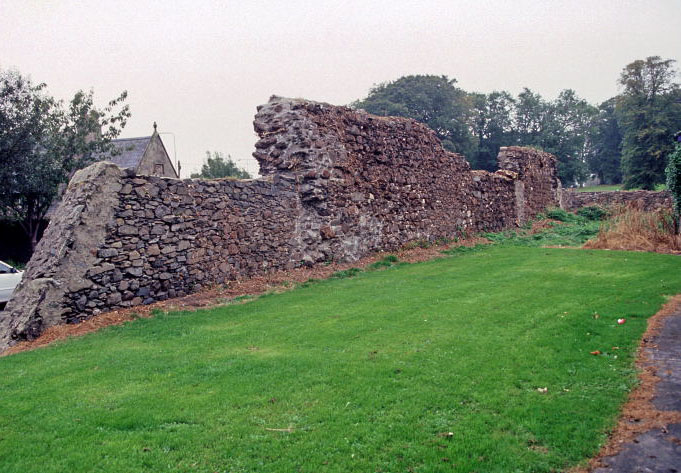
The grave found at Ballyholme in 1903 contained a pair of bronze brooches, a bowl, fragment of chain and some textile.
The brooches are known as oval brooches, one of the best-known types of Viking artefacts. Oval brooches have been studied extensively and it is possible to date them approximately, based on their form. The brooches from Ballyholme are a type which date to the later ninth century, and similar examples have been found in Dublin. Oval brooches were worn by women and were used to fasten the straps of their dresses at the shoulders.
Although the human remains were not retained with the artefacts, it is probable that this was the burial of a female. Oval brooches have almost always been found with female burials while weapons such as swords and spearheads are exclusive to male interments.
A re-examination of the original report of the discovery has led to a re-interpretation of the grave as a possible boat burial. The original report states:
Quote: There was a perpendicular cutting in the sand about 9 feet in depth, where the diggers came on a place where the earth was quite black and V-shaped. The black earth was sharply defined from the dark-red sand: the blackness commenced about 2 feet from the surface, and continued for 6 feet down, narrowing as it went down wedge-shaped. The two brooches were found at the bottom of the cutting, the hollow sides face to face.
The burial was situated immediately above the shoreline, about 2km from the famous early Medieval monastery at Bangor, which was raided by Vikings in 823 and 824. The Annals record that in 824 Vikings plundered the monastery, destroyed the oratory and killed a number of scholars and ecclesiastics and shook the relics of its founder, St. Comhgall, from the shrine.
Ballyholme Bay is a sheltered bay and studies have suggested that it is one of the best landing places on Belfast Lough and would therefore have made a good location for a Viking base. It is possible that the burial was associated with a Viking settlement in the area.
The grave was discovered during landscaping for a housing development. The area in which the burial was found has now been incorporated into the modern town of Bangor.
The Vikings in Ireland as elsewhere in Europe were not Christianised until the late tenth century. Their burial customs were pagan and the wealthiest were buried with their personal belongings. The distribution and content of pagan Viking burials in Ireland are valuable indicators of the nature of the earliest contact between the Vikings and Ireland. The largest number of burials is from Dublin, principally from the Viking Age cemeteries of Islandbridge and Kilmainham, the latter being one of the largest cemeteries known in the western Viking World.
Outside of Dublin, Church Bay on Rathlin Island is the only other probable Viking cemetery in Ireland. Other single burials include male burials at:
- Larne
- Co. Antrim
- Eyrephort, Co. Galway
- Barnhall, Co. Kildare
Female burials are known from Ballyholme, Co. Down, near Arklow, Co. Wicklow and at Navan, Co. Meath. While some of these may simply represent an isolated burial, others may be indicative of some form of Viking settlement in the vicinity. From the distribution of pagan Scandinavian burials in Ireland, it can be inferred that Scandinavian activity in the early Viking age was mostly a coastal phenomenon, and that the east coast, particularly the Dublin area, was probably of most significance in this context.
By: Maeve Sikora, National Museum of Ireland
Exercises
» The appearance of the Viking
Literature
McErlean, T., McConkey, R. and Forsythe, W. 2002. Strangford Lough. An archaeological survey of the maritime landscape.
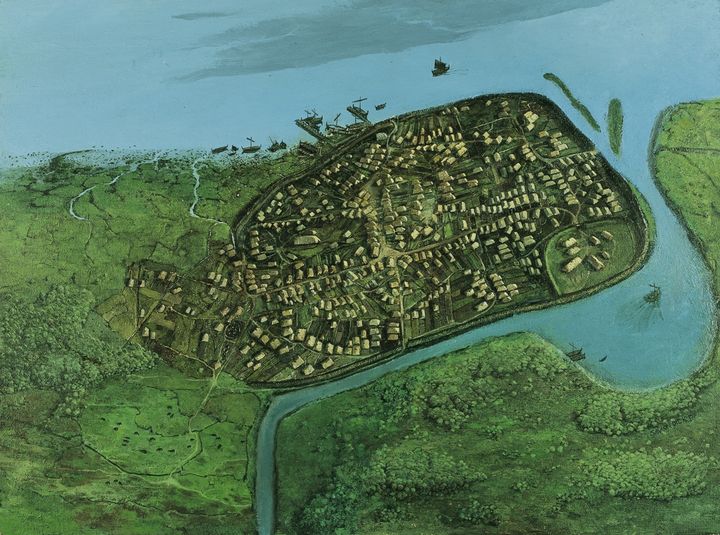
The Vikings settled in Dublin from 841 AD onwards. During their reign Dublin became the most important town in Ireland as well as a hub for the western Viking expansion and trade. It is in fact one of the best known Viking settlements.
Dublin appears to have been founded twice by the Vikings. The first foundation was as a longphort where the Scandinavians overwintered from 841AD onwards. This ended in 902 with the expulsion of the Scandinavian settlers, mainly to the north of England. They returned in 917, and the settlement was re-established and developed into the city of Dublin.
It has been argued that it was during their time in the north of England that the Norse learned about urbanisation, and it was they who brought it to Dublin in the early tenth century. After the re-establishment of Dublin and its development into a wealthy town, control of the town became a necessity for any king seeking control over all of Ireland.
Extensive excavations carried out by the National Museum of Ireland between 1962 and 1981 revealed a wealth of evidence for the post-917 settlement. The single most important result of these excavations was the information they provided about town layout in the tenth and eleventh centuries. A series of fenced plots or tenements was unearthed and could be traced over a dozen successive building levels. Apart from this, there was also important evidence for house building, and for a succession of waterfronts from between the tenth and thirteenth centuries.
The excavations in Dublin yielded evidence for a number of different building types. The typical Dublin house was a low walled, rectangular building with a doorway at either end. The main living area was a wide strip which ran between the doorways and between two raised side areas, which were often no more than raised seats or beds. A stone kerbed hearth was located in the middle of the floor area. Excavation also revealed evidence for town defences have also been found at Dublin. Dublin was enclosed by an earthen bank in the tenth century, and a second larger bank was built around the settlement in the eleventh century.
Viking Graves in Dublin
Pagan Viking graves of the ninth and tenth centuries found at Kilmainham and Islandbridge represent the earliest contacts between the Vikings and Ireland. Most of the artefacts from the graves were recovered in the course of gravel digging and in the building of the railway line in the 1840s, 50s and 60s. At least two cemeteries were located in the area and perhaps a third lay north of the Liffey in what is now the Phoenix Park. The presence of weapons, tools and brooches among the finds indicate that both men and women were buried there. The finds recovered represent at least fifty burials, and Kilmainham alone remains the largest known Viking cemetery outside Scandinavia.
Ship-building
Evidence of ship-building has also been uncovered and clearly showed that in Dublin ships were built according to Scandinavian methods. There are the remains of ships themselves, sketches of ships on planks, model- or toy ships in wood and lead fishing weights in the shape of ships. Stems, keels and nailed ship's planks, are the main parts of ships to have survived from the Viking Age levels at Dublin. So profound was the influence of Scandinavian ship-building in Ireland that many of the words in Irish for ships and their parts appear to be loan words borrowed from Old Norse.
Although Dublin began as a slaving emporium through which slaves who had been mainly collected at monasteries were shipped out to the wider Scandinavian world, it developed into the most important trading town in the western Viking world. Indeed the Irish Sea area could be regarded as a Dublin lake by the early eleventh century when Dublin's commercial contacts were at their height. It was in this context that the Skuldelev 2 ship operated.
Exercises
» English, Scottish and Irish towns
» The appearance of the Viking
Literature
Clarke, H.B., Ní Mhaonaigh, M. and Ó Floinn, R. (eds) 1998. Ireland and Scandinavia in the Early Viking Age.
P.F. Wallace, P.F. and Ó Floinn, R. (eds) 2002. Treasures of the National Museum of Ireland.
Wallace, P.F. 1992. ‘The Archaeological Identity of the Hiberno-Norse town’ Journal of the Royal Society of Antiquaries of Ireland 122, 35-66.
By: Maeve Sikora, National Museum of Ireland
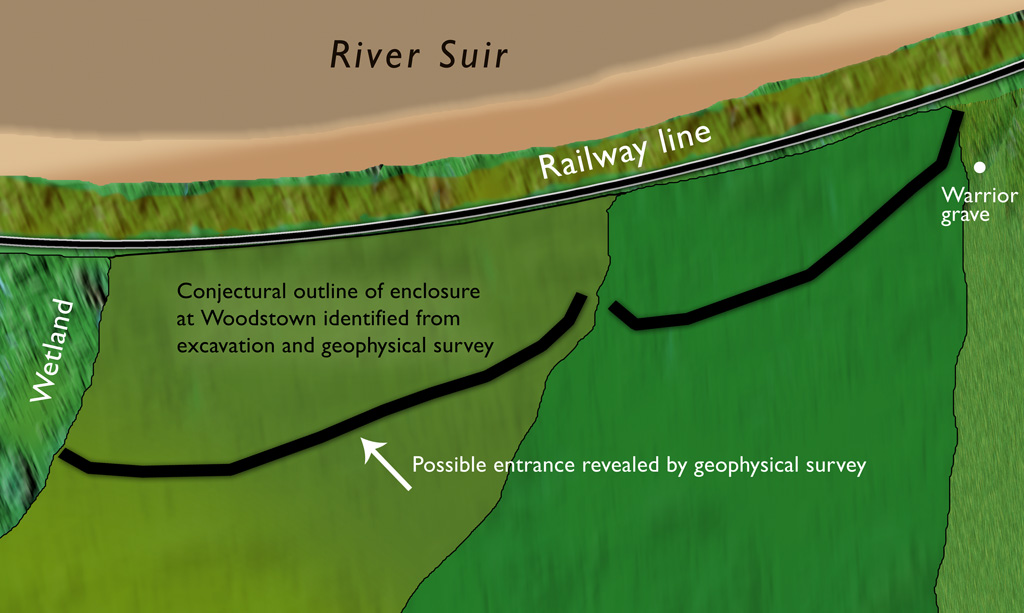
The Vikings settled in Dublin from 841 AD onwards. During their reign Dublin became the most important town in Ireland as well as a hub for the western Viking expansion and trade. It is in fact one of the best known Viking settlements.
Dublin appears to have been founded twice by the Vikings. The first foundation was as a longphort where the Scandinavians overwintered from 841AD onwards. This ended in 902 with the expulsion of the Scandinavian settlers, mainly to the north of England. They returned in 917, and the settlement was re-established and developed into the city of Dublin.
It has been argued that it was during their time in the north of England that the Norse learned about urbanisation, and it was they who brought it to Dublin in the early tenth century. After the re-establishment of Dublin and its development into a wealthy town, control of the town became a necessity for any king seeking control over all of Ireland.
Extensive excavations carried out by the National Museum of Ireland between 1962 and 1981 revealed a wealth of evidence for the post-917 settlement. The single most important result of these excavations was the information they provided about town layout in the tenth and eleventh centuries. A series of fenced plots or tenements was unearthed and could be traced over a dozen successive building levels. Apart from this, there was also important evidence for house building, and for a succession of waterfronts from between the tenth and thirteenth centuries.
The excavations in Dublin yielded evidence for a number of different building types. The typical Dublin house was a low walled, rectangular building with a doorway at either end. The main living area was a wide strip which ran between the doorways and between two raised side areas, which were often no more than raised seats or beds. A stone kerbed hearth was located in the middle of the floor area. Excavation also revealed evidence for town defences have also been found at Dublin. Dublin was enclosed by an earthen bank in the tenth century, and a second larger bank was built around the settlement in the eleventh century.
Viking Graves in Dublin
Pagan Viking graves of the ninth and tenth centuries found at Kilmainham and Islandbridge represent the earliest contacts between the Vikings and Ireland. Most of the artefacts from the graves were recovered in the course of gravel digging and in the building of the railway line in the 1840s, 50s and 60s. At least two cemeteries were located in the area and perhaps a third lay north of the Liffey in what is now the Phoenix Park. The presence of weapons, tools and brooches among the finds indicate that both men and women were buried there. The finds recovered represent at least fifty burials, and Kilmainham alone remains the largest known Viking cemetery outside Scandinavia.
Ship-building
Evidence of ship-building has also been uncovered and clearly showed that in Dublin ships were built according to Scandinavian methods. There are the remains of ships themselves, sketches of ships on planks, model- or toy ships in wood and lead fishing weights in the shape of ships. Stems, keels and nailed ship's planks, are the main parts of ships to have survived from the Viking Age levels at Dublin. So profound was the influence of Scandinavian ship-building in Ireland that many of the words in Irish for ships and their parts appear to be loan words borrowed from Old Norse.
Although Dublin began as a slaving emporium through which slaves who had been mainly collected at monasteries were shipped out to the wider Scandinavian world, it developed into the most important trading town in the western Viking world. Indeed the Irish Sea area could be regarded as a Dublin lake by the early eleventh century when Dublin's commercial contacts were at their height. It was in this context that the Skuldelev 2 ship operated.
By: Maeve Sikora, National Museum of Ireland
Literature
Clarke, H.B., Ní Mhaonaigh, M. and Ó Floinn, R. (eds) 1998. Ireland and Scandinavia in the Early Viking Age.
P.F. Wallace, P.F. and Ó Floinn, R. (eds) 2002. Treasures of the National Museum of Ireland.
Wallace, P.F. 1992. ‘The Archaeological Identity of the Hiberno-Norse town’ Journal of the Royal Society of Antiquaries of Ireland 122, 35-66.
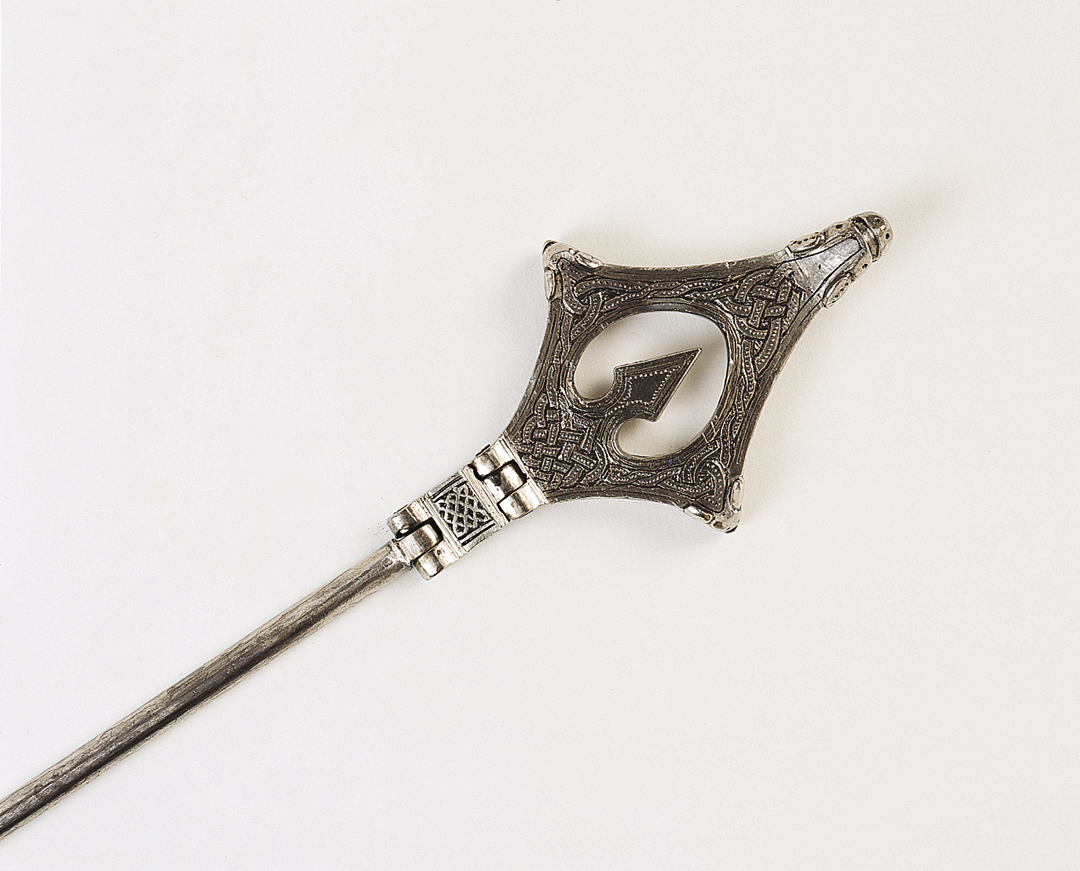
Unlike Dublin and Waterford, archaeological evidence for the Viking town of Limerick remains for the most part elusive. The majority of the evidence comes from historical sources.
The likely site of the Viking settlement is situated just north of the confluence of the river Shannon and its tributary, the Abbey river and would have been an ideal location for settlement, easy to defend and close to a crossing point.
Although there are some references to a ninth-century settlement in Limerick, the permanent settlement appears to have been established in 922AD by Tamar MacAilche. This period saw struggles between Vikings in Dublin and Limerick. Attacks by Dublin Vikings on Clonmacnoise in 942 and 946 have been interpreted as an indication that the Limerick Vikings may have been kept in a subordinate position between 937 and 967.
In 967 Limerick was captured by the Ua Briain (Dál Cáis), after which time the Hiberno-Norse town emerged. Toirrdelbach Ua Briain, King of Munster between 1063 and 1086, made Limerick his capital, and this continued during the reign of his successor, Muirchertach Ua Briain. It flourished during this period, and its first bishop was consecrated in 1107.
Although archaeological evidence in the city has yet to be uncovered, there are a number of important finds from the Limerick area.
Nordic Style Kite-brooch
During the ninth and tenth centuries large quantities of silver came into circulation in Ireland. This was largely due to Viking activity in the country, and their opening of trade routes to the east. Silver circulated in the form of coins, ornaments, ingots and hack-silver, and the artefacts are some of the most important evidence for Scandinavian activity in Ireland.
This kite-brooch, dating to the early tenth century, was found with another near the Limerick. The pair were discovered in 1845 during the construction of the Limerick-Tipperary railway line. The name kite-brooch derives from the shape of the head of the brooch, which is attached to the pin by a hinged tag. Silver kite-shaped brooches are quite rare in Ireland, and these examples are exceptionally large. The style of these brooches indicates that they have been made in Dublin, where several copper-alloy examples have been found. The size is a clear indication of the availability of large quantities of silver in Ireland at this period.
Scattery Island
Ireland’s rivers were crucial to the success of the Vikings in penetrating further inland in Ireland. Scattery Island is an island monastery in the Shannon estuary, close to Limerick. It was raided by the Vikings in the ninth century. The name Scattery is an Old Norse re-formation of the Irish Inis Cathaig. The monastery is dedicated to St. Senan. During the 970s the Annals of Inishfallen record that Norse kings of Limerick were resident at Scattery Island.
By: Maeve Sikora, National Museum of Ireland
Exercises
» English, Scottish and Irish towns
Literature
Clarke, H.B. (ed.) 1995. Irish Cities.
Wallace, P.F. 1992. 'The Archaeological identity of the Hiberno-Norse town' Journal of the Royal Society of Antiquaries of Ireland 122, 35-66.
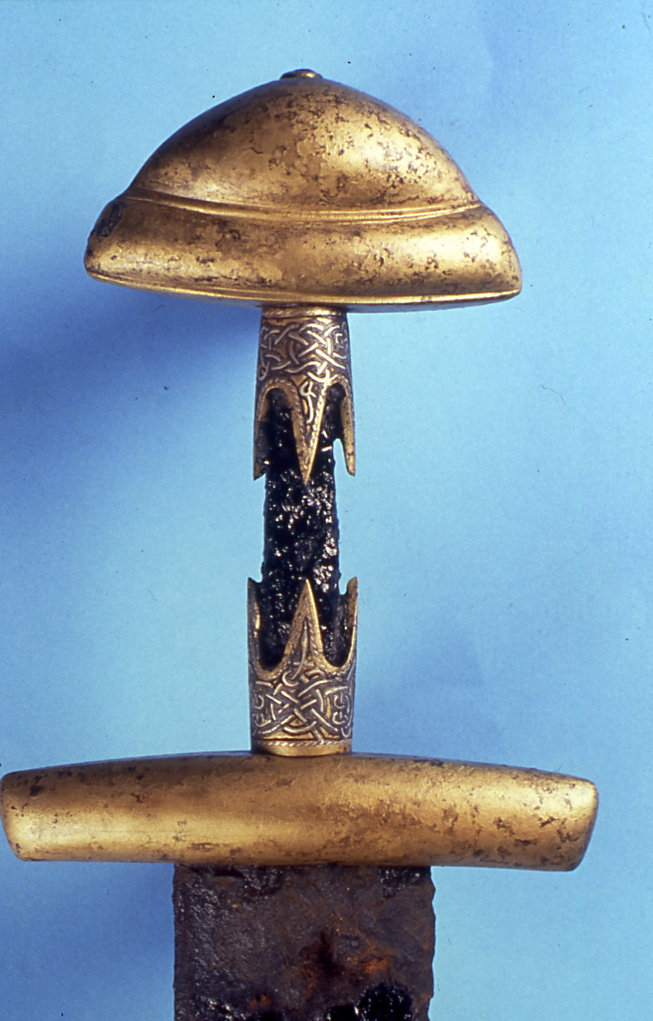
The Battle of Clontarf, fought on Good Friday in 1014 AD, is one of the most famous events in Irish history.
After the re-establishment of Dublin in 917 and its development into a wealthy town, control of Dublin became a necessity for any king seeking control over all of Ireland.
In the late tenth century the Dál Cais rose to power in Munster. Their most noteworthy king was Brian Bórama. At the turn of the eleventh century, the Norse of Dublin became involved in conflicts between Brian Bórama and the king of Leinster, Mael Morda. There were a number of serious battles in 1012, and 1013 was marked by continuous warfare. Brian, his son Murchad and Maelsechnaill II of Meath plundered Leinster, but did not succeed in their attempt to take control of Dublin.
1014 began with the Dublin Norse assembling allies from the western and northern Isles of Scotland and the Isle of Man. The ensuing battle took place at Clontarf on Good Friday in April of that year. Eventually the Leinstermen and their Norse supporters were defeated, but both sides suffered heavy casualties. Both Brian Bórama and Mael Morda were killed.
The end of the Viking era
The battle of Clontarf is often interpreted as a major defeat for the Vikings and one which changed their fortune in Europe. Certainly, the Vikings suffered great losses, and the overthrow seems to have made an impression on their saga writers, who spoke of omens before the battle, such as boiling blood raining down on the warriors.
The Battle of Clontarf was primarily a conflict between Munster and Leinster. Its outcome was less damaging to the power of the Norse of Dublin than to Munster, who did not recover for over a decade. The position of the Munstermen in Ireland was open to continuous challenge until they were overthrown by the O’Connors of Connacht and the Mac Lochlanns of Ulster a century later. Dublin's strategic position and wealth, including its powerful fleet, ensured that it was of paramount importance to those attempting to rule Ireland and between 1014 and 1170 almost all of its rulers were outsiders imposed by one or other of the kings of Connacht, Munster, Ulster and Leinster.
In the 1160s Dublin came under the dominance of Diarmuid Mac Murchadha, king of Leinster, until he was deposed by Ruaidhri Ua Concobhair in 1166. Mac Murchadha left to seek help from England, and this eventually led to the arrival of Strongbow and the capture of Dublin by the Anglo-Normans in 1170.
Exercises
Maeve Sikora, National Museum of Ireland
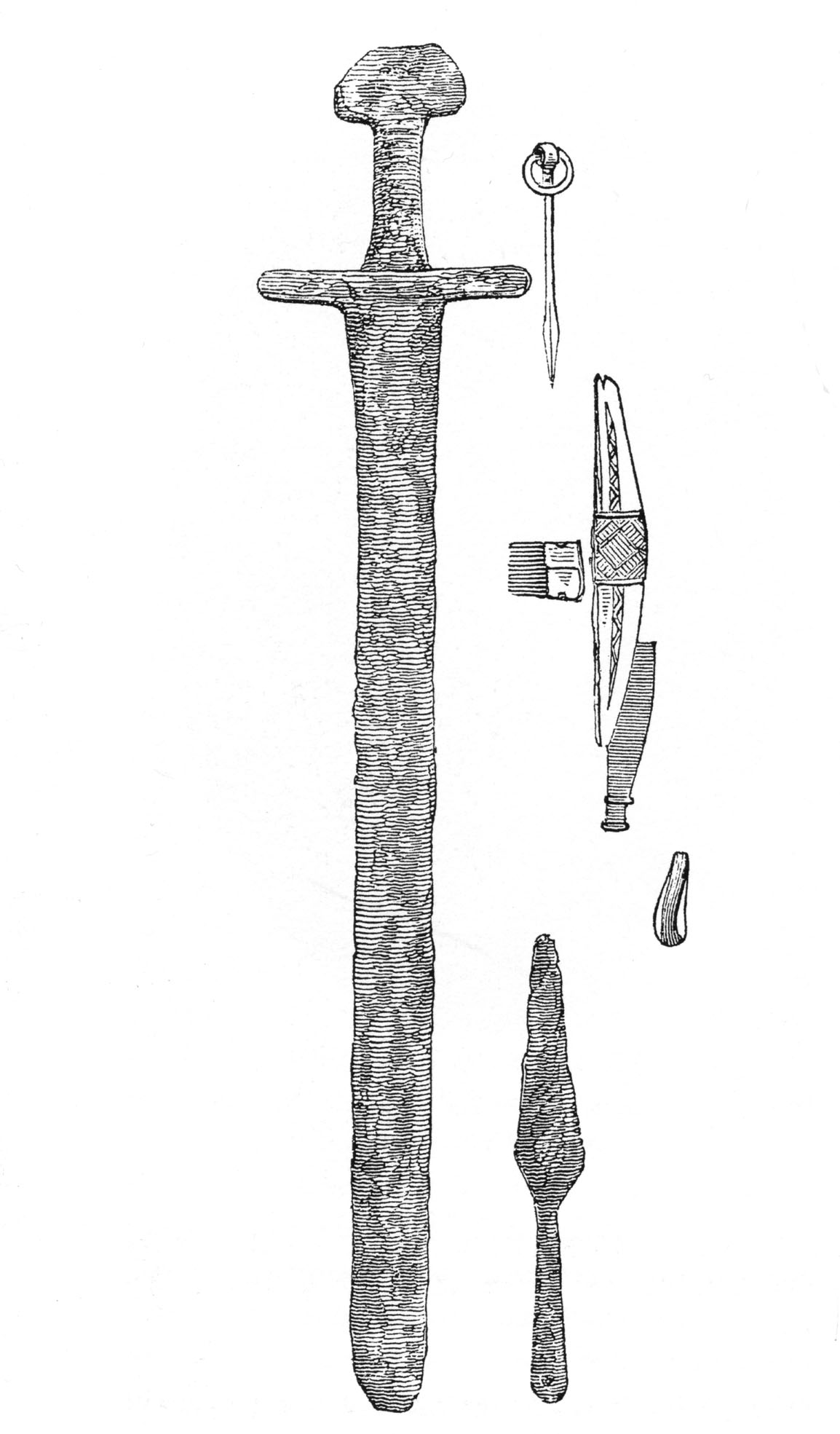
The Vikings in Ireland as elsewhere in Europe were not Christianised until the late tenth century. Their burial customs were pagan and the wealthiest were buried with their personal belongings. The distribution and content of pagan Viking burials in Ireland are valuable indicators of the nature of the earliest contacts between the Vikings and Ireland in the early Viking Age.
In 1840 a male skeleton and a number of artefacts were discovered by workmen constructing a railway line along the seashore at Larne. The grave was a simple pit dug into the sand about 1.5m above the level of the high water mark.
The man, clearly a warrior, had been buried with a double-edged Viking type sword, which was placed across his chest with the handle towards the right hand. Beneath the sword was an iron spearhead. A bronze ringed pin and a bone comb were also found.
Weapons
The sword from the Larne burial can be dated to the tenth century AD. This type of sword is relatively unusual in an Irish context. In this period, Viking weapons were different from Irish ones, and were generally of better quality. One of the legacies of the Vikings in Ireland was the introduction of new weapon types - new forms of swords and spearheads - and a higher quality of ironworking, particularly in the area of blade production. They also introduced the bow and axe to Irish warfare.
The long broad-bladed double-edged sword was the prestige weapon which often had an ornate hilt and sometimes bore a maker's mark on the blade.
Battle-axes were common and, like swords and spears, were used with shields.
The spear was the most important weapon and was used for both throwing and thrusting. Bows and arrows were common and the popularity of armour- piercing forms testify to the use of leather and chain mail armour. Although many arrowhead types are known, most were armour-piercing and archery was military related rather than for hunting.
Ringed Pin and Comb
The ringed pin from the Larne burial is a type of dress fastener that was common in Ireland in this period, and is also found in Viking graves both in Scotland and Scandinavia.
The comb is similar to a type found in graves at Birka in Sweden and also in the famous Oseberg ship burial in Norway. Combs were an important personal possession for Scandinavians in the Viking period. Written accounts from the tenth century describe how men and women combed their hair every day.
Fact: These artefacts can today be found in the collection of the Duke of Northumberland at Alnwick Castle.
It has been suggested that this burial in a simple pit may represent a fallen warrior who was given a hurried burial. However, Larne harbour has been identified with Ulfreksfjord which is written about in later historical sources and it is possible that this burial is associated with a Viking base in the area.
By: Maeve Sikora, National Museum of Ireland
Exercises
» The appearance of the Viking
Literature
Fanning, T. 1970. 'The Viking Grave Goods discovered near Larne, Co. Antrim in 1840'. Journal of the Royal Society of Antiquaries of Ireland 100, 71-78.
The Viking town of Waterford appears to have been founded around 914AD when it is recorded in the Fragmentary Annals of Ireland that 'a great fleet of Norwegians landed at Port Lairge and they plundered northern Osraige and brought spoils and many cows and livestock to their ships'.
Like Dublin, archaeological excavations in Waterford have produced a large amount of evidence for the late Viking Age and Medieval settlement. As is the case with other Viking towns in Ireland, it is situated at an easily-defended location bounded on the north by the river Suir. The name Waterford is derived from the Old Norse word for ram fjord or windy fjord.
A Viking city in 1000 A.D
Archaeological excavation in the 1980s revealed that Waterford was already a densely settled town by the mid-eleventh century, around the time that the Skuldelev 2 ship was built. The town was defended by a ditch and bank and streets fronted with houses were also in existence by this time. It appears that there were two main thoroughfares, roughly where Peter Street and High Street are today. A portion of the original surface of Peter Street was excavated and was found to measure over 2.5m wide. Its surface consisted of closely packed small stones. Houses in Waterford did face the street but were not arranged like a modern-day street front. There was variation in the orientation and position of houses, and street fronts were not always occupied by a house. Although actual boundary fences were not always found, there is evidence for continuity of plot orientation, as was the case in Dublin. Most of the houses in Waterford were of the three-aisled type, with clay floors and wattle walls, again comparable to the type found in Dublin. In some places, excavations showed that at least seven different houses had been superimposed on the one site, between the eleventh and the mid-twelfth century.
Finds from the excavations reveal the prosperity of some inhabitants – a beautiful kite-shaped brooch decorated with gold filigree was recovered from an eleventh century context. Pottery was imported from the south of England, and trade links were also maintained with north-west France. As in Dublin, archaeologists also found evidence for comb-making. A number of ship timbers were also found here.
By the early twelfth century Viking settlers in Waterford were Christian, and two churches are know to have existed – St. Olaf’s and St. Peter’s. Interestingly, the form of St. Peter’s church with a semicircular apse is unique in the context of parish churches in Ireland. Apses are a feature of Saxon churches in Britain, and the presence of this in Waterford indicates strong cultural links with England at this time.
Waterford’s defences appear to have been very extensive. Where excavated, the ditch measured up to 2.5m deep, and more than 8m wide in places. A large stone wall was built outside the ditch. The strength of the town’s fortifications is confirmed by twelfth century accounts, which state that it took Raymond Le Gros and Strongbow's forces three attempts to take the city. Reginald's tower, an Anglo-Norman building, may have been the location of an earlier Viking tower. It was in that tower that Ragnall, Prince of the Danes of Waterford, was imprisoned by the Normans in 1171.
By: Maeve Sikora, National Museum of Ireland
Exercises
» English, Scottish and Irish towns
Literature
Ryan, M. (ed.) 1994. Irish Archaeology Illustrated.
Hurley, M., Scully, O.M.B., Cleary, R.M. & McCutcheon, SW.J. 1997.Late Viking Age and medieval Waterford. Excavations 1986-1992.

In 2003 archaeological investigations along the route of a proposed road near Waterford city uncovered a large number of Viking artefacts including lead weights and silver ingots.
The site was in the townland of Woodstown, on the south bank of the river Suir west of Waterford city. From preliminary investigations, it appears to have been a Viking longphort, or ship fortress, similar to those described in the annals at locations such as Dublin and Annagassan. Excavation also revealed a Viking warrior burial containing a sword, spearhead, a ringed pin and a spear ferrule among other artefacts. Most of the artefacts in the grave indicate a ninth century date, which would correspond to the period in which the Vikings were establishing longphuirt in Ireland.
Only a portion of the site was excavated, after which it was decided that the road would be re-routed. A research excavation is planned and it is hoped that this will yield more information regarding the nature and duration of the Viking settlement here.
By: Maeve Sikora, National Museum of Ireland
Exercises
» The appearance of the Viking
Literature
O’Brien, R. Quinney, P. and Russell, I. 2005. Preliminary report on the Archaeological excavation and finds retrieval strategy of the Hiberno-Scandinavian site of Woodstown 6, Co. Waterford. Decies: Journal of the Waterford Archaeological and Historical Society 61, 13-122.
Literature
Edwards, N. 1990. The Archaeology of Early Medieval Ireland
Clarke, H.B., Ní Mhaonaigh, M. and Ó Floinn, R. (eds). 1998. Ireland and Scandinavia in the Early Viking Age.
Sawyer, P. (ed). 1997. The Oxford Illustrated History of the Vikings.
Wallace, P.F. and Ó Floinn, R. (eds) 2002. Treasures of the National Museum of Ireland.
Maeve Sikora, National Museum of Ireland
